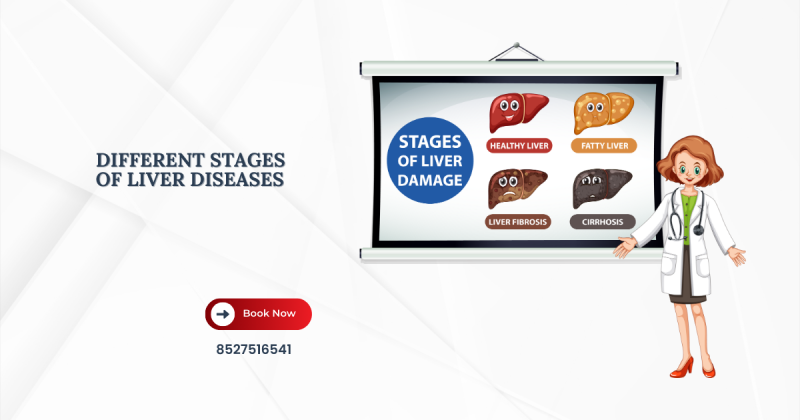Health
Different Stages of Liver Diseases

Introduction
When we think about the liver, we usually imagine a silent worker inside our body, quietly performing hundreds of life-saving tasks. From detoxifying our blood to storing energy, the liver is like the body’s personal housekeeping team. But what happens when this vital organ starts to struggle? Liver disease does not happen overnight—it progresses in stages, each one with its own signs and consequences.
In this article, we’ll break down the different stages of liver diseases in simple, easy-to-understand language. Think of it like climbing a staircase: each step brings you closer to more serious conditions. By the end, you’ll not only understand the stages but also know why early care—and sometimes even consulting the best liver transplant surgeon in India—can be life-saving.
1. What Does the Liver Do and Why Is It Important?
The liver is often compared to a filter and factory combined. Just like a water filter cleans impurities, the liver removes toxins from your blood. At the same time, it works like a factory—producing proteins, enzymes, and bile that help with digestion and nutrient absorption. Without a healthy liver, the entire body suffers.
2. Early Stage: Fatty Liver Disease
The first step in liver damage is usually fatty liver disease. This is when fat builds up inside liver cells. Imagine stuffing too much cotton into a pillow—the pillow becomes lumpy and uncomfortable. Similarly, excess fat makes the liver swollen and stressed.
At this stage, symptoms may be mild or even invisible. Many people only find out during routine checkups.
3. Causes and Risk Factors of Fatty Liver
Several factors can lead to fatty liver:
- Unhealthy diet rich in fried foods and sugar
- Obesity or being overweight
- Excessive alcohol consumption
- Sedentary lifestyle
- Diabetes and high cholesterol
The good news? Fatty liver is reversible with diet, exercise, and lifestyle changes if caught early.
4. Second Stage: Liver Inflammation (Hepatitis)
If fatty liver continues unchecked, it can lead to hepatitis, which means inflammation of the liver. Think of it as your body raising a red flag, signaling that the liver is irritated. Hepatitis can be caused by infections (like Hepatitis A, B, or C), alcohol, or autoimmune issues.
5. Common Symptoms of Hepatitis
Some people may not notice hepatitis at first, but common warning signs include:
- Constant fatigue
- Yellowing of the skin and eyes (jaundice)
- Loss of appetite
- Abdominal discomfort
- Dark urine
6. Third Stage: Fibrosis of the Liver
When inflammation stays for too long, it causes scarring of the liver tissue, known as fibrosis. Picture a wound healing with scar tissue—except inside the liver, these scars start to replace healthy cells, making it harder for the liver to do its job.
7. How Fibrosis Affects Liver Function
Fibrosis reduces blood flow through the liver. Over time, this “traffic jam” inside the liver slows down detoxification, nutrient processing, and protein production. Without intervention, fibrosis can silently progress to cirrhosis.
8. Fourth Stage: Liver Cirrhosis
Cirrhosis is advanced scarring. Here, large portions of the liver are permanently damaged. The once smooth, spongy organ becomes hard and bumpy, like a dried sponge. Cirrhosis can be caused by chronic alcoholism, viral hepatitis, or untreated fatty liver.
9. Complications of Cirrhosis
Cirrhosis can lead to:
- Bleeding due to poor clotting ability
- Ascites (fluid buildup in the abdomen)
- Varices (swollen veins in the food pipe that may rupture)
- Hepatic encephalopathy (confusion due to toxin buildup in the brain)
- Higher risk of liver cancer
At this point, damage is usually permanent.
10. Advanced Stage: Liver Failure
Liver failure means the organ can no longer function. The “factory” has shut down, and toxins build up dangerously. Patients with liver failure often require hospitalization, intensive treatment, and in many cases, a liver transplant to survive.
11. When Is a Liver Transplant Needed?
A liver transplant is recommended when:
- The liver is so damaged it cannot regenerate
- Cirrhosis has led to life-threatening complications
- There’s no improvement with medicines or lifestyle changes
It’s a life-saving procedure that can give patients a second chance.
12. Role of the Best Liver Transplant Surgeon in India
For those in India facing advanced liver disease, finding the best liver transplant surgeon in India is crucial. A skilled surgeon not only performs the complex surgery with precision but also guides patients through pre- and post-transplant care. The expertise of such surgeons can mean the difference between a smooth recovery and ongoing complications.
13. Lifestyle Changes to Protect Your Liver
Even if you don’t have liver disease, protecting your liver should be a priority. Simple steps include:
- Eating a balanced diet with fruits, vegetables, and whole grains
- Avoiding excess alcohol
- Staying physically active
- Maintaining a healthy weight
- Getting vaccinated against Hepatitis A and B
- Avoiding unnecessary medications and self-medication
14. Diagnostic Tests for Liver Disease
Doctors may suggest several tests, such as:
- Blood tests (liver function tests)
- Ultrasound or CT scans
- Liver biopsy to check scarring
- Fibroscan (non-invasive test to measure liver stiffness)
Early diagnosis is the key to preventing disease progression.
15. Can Liver Damage Be Reversed?
The answer depends on the stage. Fatty liver and early hepatitis can often be reversed with lifestyle changes. Fibrosis may be slowed or improved. But cirrhosis and liver failure are generally irreversible, making prevention and early care critical.
16. Conclusion
The liver’s journey from fatty buildup to complete failure is like walking down a path with warning signs at every step. Recognizing these stages early can save lives. And for those at advanced stages, consulting the best liver transplant surgeon in India can open the door to a healthier future. Remember, the liver is your body’s powerhouse—take care of it before it’s too late.
17. FAQs
Q1. What are the first signs of liver disease?
The earliest signs include fatigue, loss of appetite, mild abdominal discomfort, and sometimes unexplained weight changes.
Q2. Can liver disease be cured completely?
In early stages like fatty liver, yes. But advanced conditions like cirrhosis and liver failure usually cannot be fully cured—only managed or treated with a transplant.
Q3. How long can someone live with cirrhosis?
It depends on severity, complications, and treatment. With proper care, some people live for years, but advanced cirrhosis often shortens life expectancy.
Q4. Is liver transplant the only option for liver failure?
Yes, in most cases. When the liver can no longer function and medicines fail, a transplant is the only life-saving treatment.
Q5. How can I find the best liver transplant surgeon in India?
Look for hospitals with specialized liver units, experienced surgeons with high success rates, and positive patient feedback. Consulting trusted specialists ensures better outcomes.
Would you like me to also add internal linking strategies (like suggesting related topics such as “liver transplant success rates in India” or “cost of liver transplant”) to further optimize this article for SEO?
Source:
Click for the: Full Story
You might like













 Close Menu
Close Menu